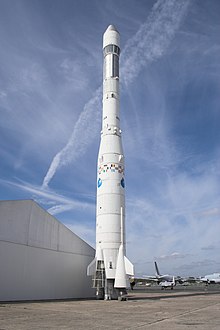Ariane 1
 | |
| Function | Medium Lift Launch System |
|---|---|
| Manufacturer | Les Mureaux for ESA |
| Country of origin | |
| Size | |
| Height | 50 m (164 ft) |
| Diameter | 3.8 m (12.4 ft) |
| Mass | 207,200 kg (456,700 lb) |
| Stages | 4 |
| Capacity | |
| Payload to LEO | 1,400 kg |
| Payload to GTO | 1,850 kg |
| Launch history | |
| Status | Retired |
| Launch sites | ELA-1, Guiana Space Centre |
| Total launches | 11 |
| Success(es) | 9 |
| Failure(s) | 2 |
| First flight | 24 December 1979 |
| Last flight | 22 February 1986 |
| Type of passengers/cargo | Giotto |
| First stage | |
| Engines | 4 Viking-2 |
| Thrust | 2,771.940 kN (623,157 lbf) |
| Specific impulse | 281 s |
| Burn time | 145 seconds |
| Propellant | UDMH/N2O4 |
| Second stage | |
| Engines | 1 Viking-4 |
| Thrust | 720.965 kN (162,079 lbf) |
| Specific impulse | 296 s |
| Burn time | 132 seconds |
| Propellant | UDMH/N2O4 |
| Third stage | |
| Engines | 1 HM7-A |
| Thrust | 61.674 kN (13,865 lbf) |
| Specific impulse | 443 sec |
| Burn time | 563 seconds |
| Propellant | LH2/LOX |
| Fourth stage | |
| Engines | 1 Mage 1 |
| Thrust | 19.397 kN (4,361 lbf) |
| Specific impulse | 295 sec |
| Burn time | 50 seconds |
| Propellant | HTPB (solid) |
Ariane 1 is the first version of the Ariane launcher family. Ariane 1 was designed primarily to put two telecommunications satellites at a time into orbit, thus reducing costs. As the size of the satellites grew Ariane 1 began to give way to the more powerful Ariane 2 and Ariane 3 launchers.[1]
Vehicle Description
Ariane 1 was the first launch vehicle to be developed by the European Space Agency. It was developed from the L3S Europa launch vehicle replacement design. The development of the vehicle was authorized in July 1973. The cost of program is estimated at 2 billion euros. With lift-off mass of 210,000 kg (460,000 lb), Ariane I was able to put in geostationary orbit one satellite or two smaller of a maximal weight of 1,850 kg (4,080 lb).
The Ariane 1 was a four stage vehicle. The first stage was equipped with 4 Viking engines developed by the Société Européenne de Propulsion. The second had a single Viking engine.
The third stage had one LOX/LH2 bipropellant engine capable of a thrust of 7,000 kgf (69 kN). The fourth stage was powered by a single Mage-1 solid rocket booster producing a thrust of 20 kN
This design would be kept until Ariane 4.[2]
Launches
The first launch was on 24 December 1979, and was successful. The second launch, in 1980, failed shortly after launch due to a combustion instability in one of the Viking first stage engines. The third launch succeeded in orbiting three satellites, and the fourth and last qualification launch was also a success.
During the next launch, the first commercial one, the rocket ceased functioning after 7 minutes of flight due to a turbopump failure in the third stage. After a complete review of the launcher, the next 6 flights were all successful. The Giotto mission's spaceprobe was successfully launched on the tenth Ariane 1 (flight V14) on 2 July 1985.
The first SPOT satellite was put into orbit by the eleventh and last launch of Ariane I, which was on 22 February 1986.[3]
Launch History
| Flight | Date | Launch Pad | Payload | Outcome | Remarks |
|---|---|---|---|---|---|
| L-01 | 24 December 1979 | ELA-1 | CAT-1 | Success | First Flight |
| L-02 | 23 May 1980 | ELA-1 | Firewheel Subsat-1,2,3,4 Amsat P3A CAT 2 |
Failure | Combustion instability in one of the Viking first stage engines |
| L-03 | 19 June 1981 | ELA-1 | Meteosat 2 Apple CAT 3 |
Success | |
| L-04 | 20 December 1981 | ELA-1 | MARECS 1 CAT 4 |
Success | |
| L-5 | 10 September 1982 | ELA-1 | MARECS B Sirio 2 |
Failure | First commercial launch The rocket ceased functioning after 7 minutes of flight due to a turbopump failure in the third stage |
| L-6 | 16 June 1983 | ELA-1 | ECS 1 Amsat P3B (Oscar 10) |
Success | |
| L-7 | 19 October 1983 | ELA-1 | Intelsat 507 | Success | |
| L-8 | 5 February 1984 | ELA-1 | Intelsat 508 | Success | |
| V-9 | 23 May 1984 | ELA-1 | Spacenet 1 | Success | |
| V-14 | 2 July 1985 | ELA-1 | Giotto | Success | |
| V-16 | 22 February 1986 | ELA-1 | SPOT 1 Viking |
Success | Last Flight |
References
- ^ "Ariane 1,2,3". Ariane 1. ESA. 2004-05-04. Retrieved 2009-09-28.
- ^ "Ariane rocket family". Mark Wade. Astronautix. 2004-05-04. Retrieved 2009-09-28.
- ^ "Launch History". Ariane 1. Gunter's Space Page. 2009-04-16. Retrieved 2009-09-28.
